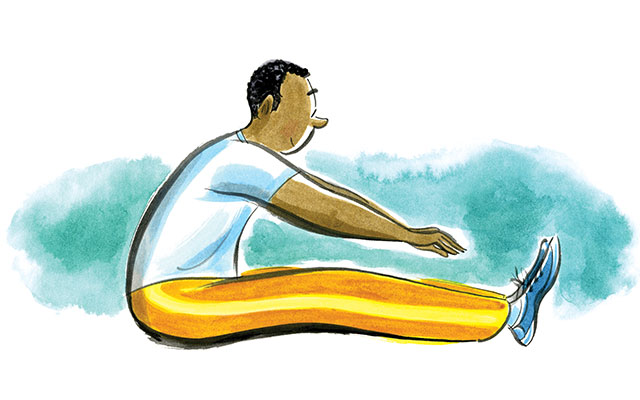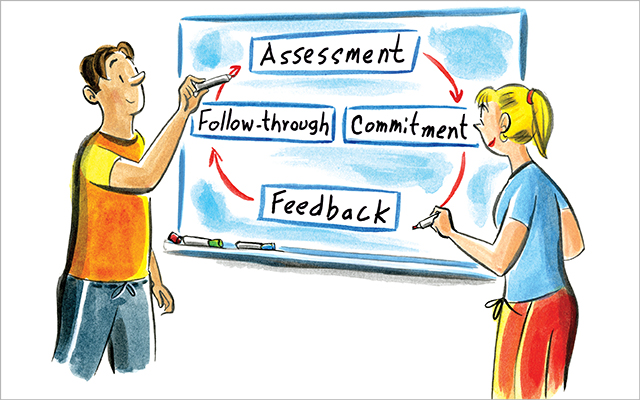If you’d like to launch a fitness program, or ramp up your current one, summer is a great time of year to do it. But that initial motivation is only the first ingredient. You also need a solid plan and a healthy frame of mind.
That’s because the most daunting barriers to beginning or upgrading a fitness program rarely concern the body. Instead, they center around things like time, focus, and creativity in overcoming obstacles.
Identifying and addressing these likely barriers requires some forethought. But with a little bit of planning and introspection, you can launch an enjoyable, sustainable program — one that not only supports your current health and fitness goals, but also puts you on a path toward a healthier future.
From Choice to Challenge
It’s one thing to say, “I want to get in shape.” It’s quite another to determine what exactly you’re prepared to change, and what kinds of support you’ll need in order to start and keep moving forward.
“Most people genuinely want to do their best, but their belief systems, lack of clarity, or lack of support get in the way,” says Kate Larsen, author of Progress Not Perfection: Your Journey Matters and a certified life, executive, and wellness coach based in Minneapolis.
Coaches like Larsen help clients address such issues directly — and then help them brainstorm plans and solutions. But if you’re not quite ready to work with a coach, says Larsen, you can still benefit from working through a step-by-step self-coaching process.
A successful fitness plan involves four basic phases that, taken together, form a repeating, cyclical process: assessment, commitment, feedback, and follow-through. In this article, we’ll help you establish a strategy that offers both immediate motivation and lasting support for your goals.
Before you begin, take out a notepad or journal so you can document your answers to the questions that follow. Your notes will become the basis of your plan — and will serve as a powerful resource during times of flagging focus. After all, preparing for challenges is what successful fitness planning is all about.
Assessment: Where You’re At and Why
Where are you now?
The objective of the assessment phase is for you to figure out where you currently stand, what you want, and what’s driving your desire.
What health and fitness blessings can you count today? What, if anything, is bringing you down? Are you satisfied with the way your body feels and performs? Or are you longing to improve your energy and strength, to become more flexible, to upgrade your sports performance, improve your posture, or increase your stamina for daily living?

How much exercise are you getting now, and what type? If you’re coming off an exercise lapse, get a checkup to make sure you’re healthy en
ough for regular exercise. This will give you an opportunity to take some benchmark measurements, too, such as blood pressure, cholesterol and triglycerides, blood sugar, and weight.
You can also go a step further and get fitness testing (metabolic assessment, body composition, and so on) completed at your local health club or sports clinic. Or conduct your own mini-assessment by timing yourself walking or jogging a mile so you’ll have numbers to compare later.
What do you desire?
What larger benefits would you like to achieve by becoming fitter? Is being healthy and fit one of your core values, or a means of supporting a core value? Make a list of the personal values driving your fitness endeavors.
What are the priorities in your life? How will becoming fitter affect them? Note the obligations and pastimes that may take a back seat as you proceed, as well as those likely to climb in importance.
Write down your fitness vision in the present tense: “It’s one year from now, and I am _______.”
Be detailed about what you are doing and experiencing, as well as how you’re feeling.
What are the forces at play?
Give some thought to the life circumstances and contexts that are likely to influence your fitness efforts and ambitions now. Here are a few questions to consider:
- When were you at your healthiest and fittest? What were the factors at work then, and how might you employ some of them now?
- Which of your habits or attitudes contribute to poor fitness? Which do you feel motivated to change?
- Who or what in your life encourages you? What support systems do you have or can you easily cultivate?
- Who or what may be an obstacle (internal and external)? What can you do to work around potentially negative influences?
- What necessary skills or resources might you lack, and which do you have that you could apply to this effort?
Assessment Question: What’s the best use of my energy now?
Commitment: Develop an Action Plan

If you’ve worked through the questions in the assessment section, you probably have a good sense of the commitment you’re energized to make. You also have a sense of the actions you’ll need to take in addressing potential obstacles.
Spend a moment articulating your fitness commitment on paper (just a simple sentence or two will do), then sign your name beneath it. Let this represent your contract with yourself.
For long-term success, a plan that takes into account an individual’s lifestyle, personality, and values is very valuable, says Paul Kriegler, assistant program manager of Life Time Weight Loss. “People know they are unique, and if a plan doesn’t work for them, they won’t stick with it. A personalized plan shifts the focus from ‘a plan’ to ‘my plan.’ There’s emotional buy-in.”
Your next step is to consider what it will take to realistically fulfill this commitment. Most goal-setting experts advise creating SMART goals — goals that are specific, measurable, attainable, reasonable, and time-anchored. While this is a good and informative exercise, it can also bog down some people in details they aren’t quite ready to address.
If you’re motivated to define your goals in SMART language, go right ahead.
If not, your plans can still take concrete shape. Consider addressing five key questions: What? Who? When? Where? How?
What?
- What life changes are you willing to embrace to demonstrate that health and fitness are priorities? What types of changes are most energizing and appealing to you now? What resources and how much time can you commit?
Who?
- Who will be involved in supporting your fitness program? You may want to draw on the support of an exercise buddy, a personal trainer, or a life coach.
- In what ways can you ask your spouse or partner, family members, friends, or coworkers to support you?
When?
- How often will you be active, for how long, and over what period of time? Commit to a specific number of workouts, even if it’s just one walk each day for the next month.
- Planning when you’ll exercise (and marking it on your calendar) makes you far more likely to do it. Create a log or check-off system to make your commitment visible and help you track your progress.
Where?
- Where will you be working out? Make a list of the places near home and work where you can incorporate activity.
How?
- How will you stay motivated to stick with your plan? For some people, hiring a personal trainer or joining a fitness group is the answer. For others, it’s regular check-ins with a fitness buddy or tangible rewards for meeting small goals along the way.
- How will you track your achievements? Set some check-in dates now and decide which metrics you’ll assess.
- How will you celebrate your successes — not just for achieving your goals, but also for reaching key points along the way?
Commitment Question: How will I act on and support my choices?
Feedback: Work the Plan, Observe the Results

From the moment you begin your program, you’ll start receiving feedback, but it’s a good idea to make a point of formally collecting it on a weekly basis.
No matter how solid your strategy seems when you set it, you’ll inevitably learn that some aspects of your plan work better than others. And you may encounter some challenging or uplifting factors that you never planned for at all. That’s why monitoring your progress, and being willing to adapt and change your program, is essential.
According to Kriegler, a key factor in successfully setting, reaching, and following through with goals is having the right mindset. Successful people see challenges and obstacles as bumps in the road, not deterrents. “They celebrate small wins throughout the process, not just the final outcome, which builds confidence and promotes progress.”
You skipped a workout? OK. Why and how did that happen? What were the circumstances that contributed? Ask these questions during the feedback phase:
What’s working? What’s not?
- How realistic is your plan turning out to be? How satisfying is it? What parts are you enjoying most? Least?
- Where are you running into trouble? Under what circumstances (physical, mental, emotional, schedule related) do you tend to lose steam or get discouraged, and when do you get revved up?
- Are there other life demands affecting your fitness progress? How can you modify your program?
- Would developing certain skills (time management, healthy cooking) help you overcome obstacles? Would additional support (from family, a workout buddy, a trainer, a nutrition expert) help you make better progress or enjoy the process more?
What could be better?
- Are you seeing or feeling some encouraging results? Feeling some frustration or impatience? Take note of areas of success and challenge.
- Are you having fun? Experiencing some stress relief? Getting a boost in self-esteem or other “soft” but notable results?
- Are you getting the kind of nutrition you need to support your fitness goals? Are your eating habits limiting your energy and vitality, or are they fighting your weight management efforts?
- Are your plans to benchmark your progress and patterns working for you? Do you need better feedback?
What next?
- Are things getting easier? Are you getting bored? Do you need some inspiration or accountability? Are you ready to step it up or try something new?
- Are you feeling overwhelmed and exhausted? Injured? Do you need to take a step back? Do you need to ask for help?
- As you pursue the program you’ve designed, keep watching and asking what has happened — and what’s happening now. Without judgment, learn from your experiences and improve your plan as you go. And remember to celebrate the small wins along the way!
Feedback Question: How am I doing so far and what am I learning?
Follow-Through: Making Midcourse Corrections

The follow-through stage is your opportunity to act on the information you’ve gathered during the feedback phase.
Ideally, feedback and follow-though are continuous and interconnecting processes that are going on all the time. But you may want to establish some formal check-in dates (say, every two weeks) for sitting down to evaluate feedback, then building appropriate plans for follow-through and troubleshooting into your larger strategy.
Based on the feedback you’ve observed, identify some priority areas for adjustment or deeper work. Look back on the notes you gathered during the feedback phase, then identify at least three follow-through adjustments that deserve action.
Consider likely candidates from the following areas:
- Time and energy management, scheduling
- Soundness of plan and available resources
- Mental and emotional attitude, focus
- Nutritional support and eating habits
- Nature of fitness activities (frequency, variety, intensity, fun, challenge, etc.)
Document key changes in your workbook or journal, and make any necessary alterations to your schedule.
The Cycle Begins Anew
Once you’ve incorporated your follow-through adjustments and had a chance to observe the results, you effectively begin the assessment phase all over again.
This is a good time to analyze your overall effort and results. How realistic were your original goals, and should they evolve? How well did you treat yourself as your plan progressed?
Success or failure against the original goals isn’t the issue here. The biggest potential win lies in creating success by harvesting the acquired wisdom. It’s about implementing what you’ve learned in ways that respect your highest choices, now. It’s about celebrating your fitness gains and your personal insights in a way that inspires you to continue building on forward momentum.
Nobody knows the real you — your hopes, your dreams, your values — better than you know yourself. And when you act as your own fitness coach, you discover how you’re wired and what makes you tick.
You become the architect of your own success, the holder of the blueprints for the fitness future that excites you most of all.
Follow-Through Questions: What’s the best thing to do now? What could I be doing differently?
This article originally appeared as “The Can-Do Fitness Plan.”




This Post Has 0 Comments